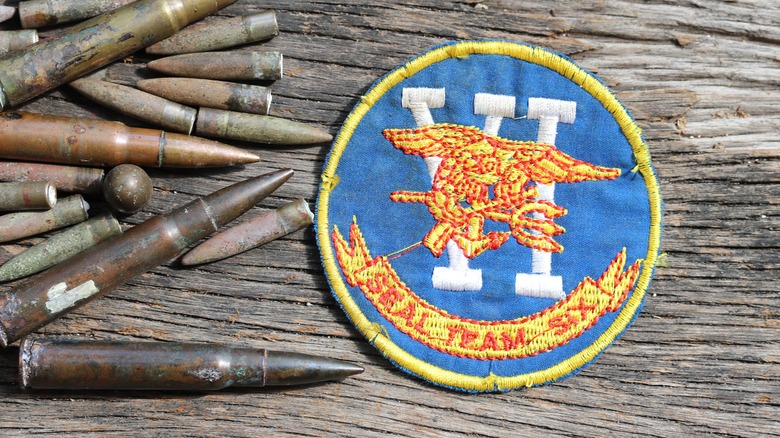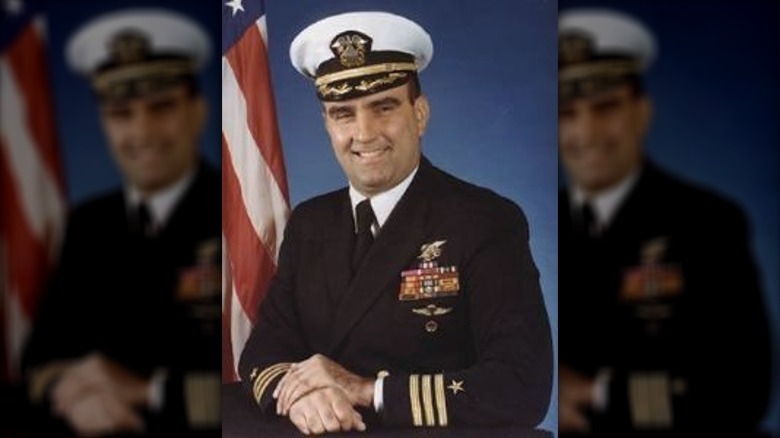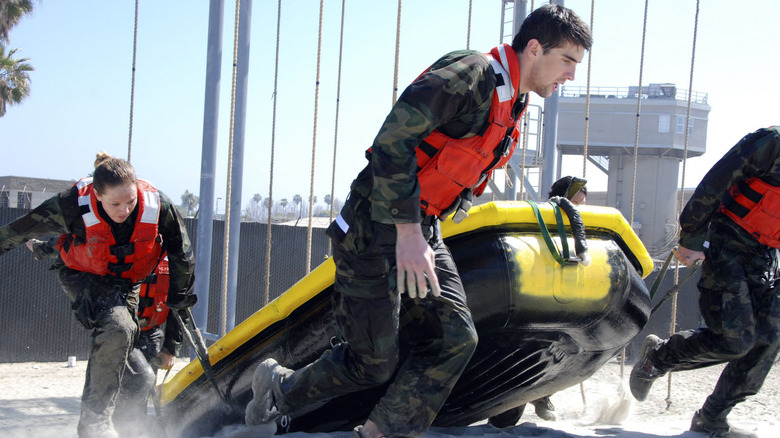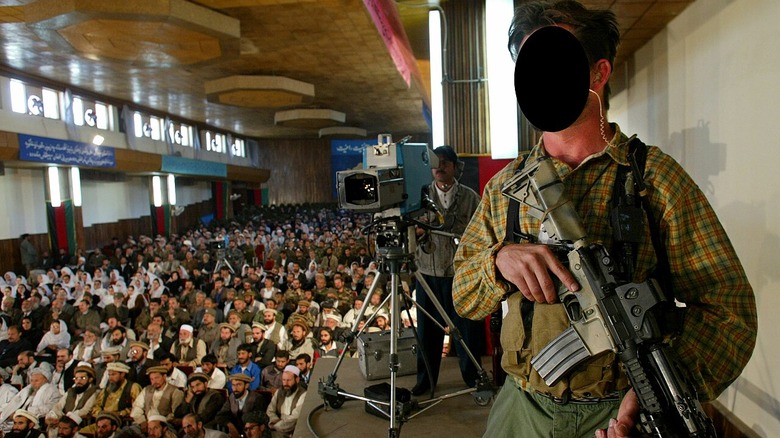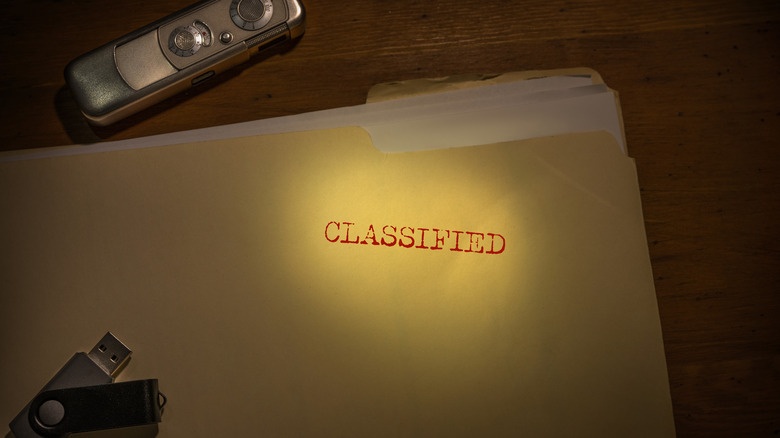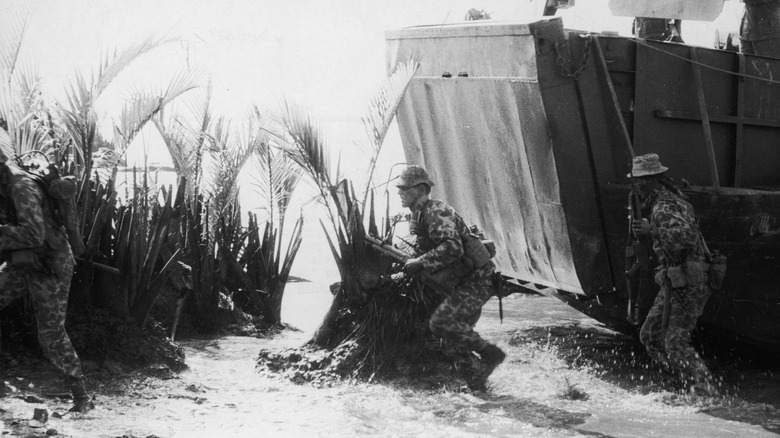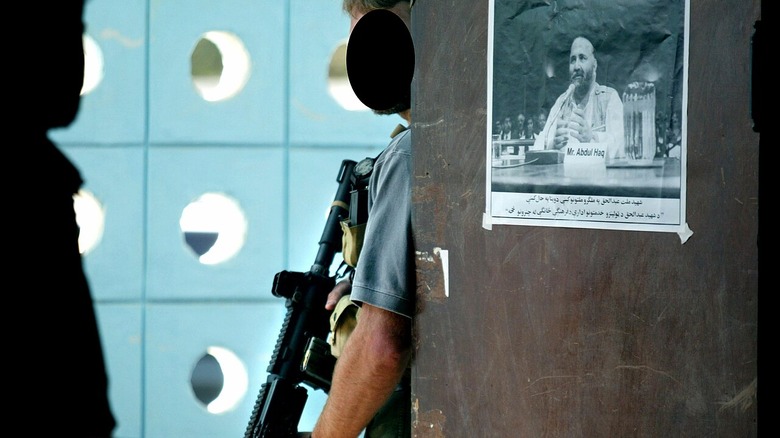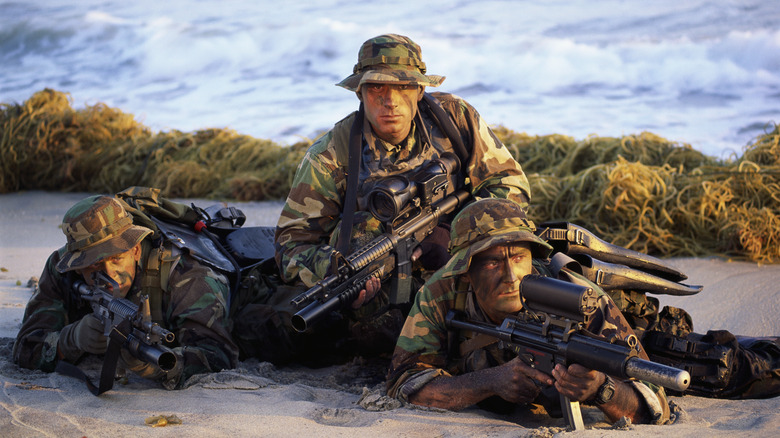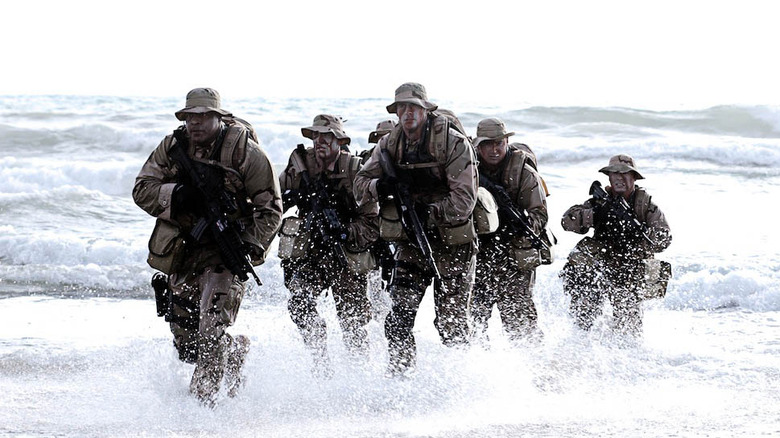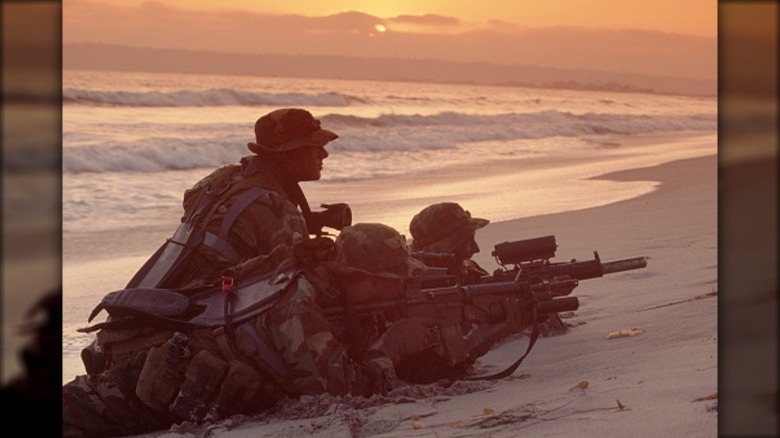Odd Rules SEAL Team Six Has To Follow
The history of the Joint Special Operations Command, known as JSOC, is surprisingly well known. It started with the 1979 Iran Hostage Crisis, the infamous event in which Iranian students stormed the U.S. embassy and took dozens of Americans hostage. The U.S. government made plans for a potential rescue operation, codenamed Operation Eagle Claw, but the mission was deemed a failure. The mess ultimately highlighted the weaknesses of the U.S. military and led to the creation of the Special Operations Command (SOCOM, later JSOC), consequently spawning endless questions about the truth of the Army's Intelligence Support Activity, Delta Force, and, of course, the Navy's SEAL Team Six.
The untold truth of SEAL Team Six (known presently as DEVGRU) is highly secretive, making details about their operation fairly hard to come by — and making accountability a complicated topic. While other military units are often known for following strict sets of rules, SEAL Team Six isn't. Seen as something akin to rogues, the unit has come under the fire of critics who allege that its members act with too much leniency and employ violence all too readily. Reports of SEALs mutilating bodies, terrorizing villages, or even running summary executions — it seems as though there's so little oversight that some claim the unit is responsible for chasing people into the arms of terrorists. Still, there are some odd rules and traditions that the unit does abide by, and here are some of them.
The original rules of SEAL Team Six
SEAL Team Six has something of a storied history, and not always for the best of reasons. In 1980, SEAL Team Six was founded by Navy SEAL Richard Marcinko (pictured above), who came into the project with the plan to build an elite unit of soldiers made somewhat in his image. These weren't the perfect, disciplined, obedient soldiers that he wanted; his call was for the rebels, the outlaws, the criminals. In his own words, "If you want to call them sociopaths, you can ... SEAL Team Six is not really a military unit as much as it is a mafia" (via Rolling Stone).
In keeping with that, members of the original incarnation of SEAL Team Six were expected to fit into Marcinko's band of outlaws. Soldiers who joined and tried to enforce discipline (or complained about the lack of it) were swiftly kicked out of the unit, and Marcinko explained that he wanted any problems to stay in-house — within the family — while painting himself as a pseudo mob boss. No outsiders were to get involved; that's just how he ran things.
There was another unofficial rule: Members had to be able to hold their alcohol. Marcinko explained, "I used alcohol as a tool," and typically conducted his interviews in a bar. Given that Marcinko himself was a heavy and enthusiastic drinker, if a potential recruit couldn't keep drinking with him, then they weren't making it into the unit.
They need to undergo an intense recruitment first
With SEAL Team Six being one of the most elite military units in the U.S., it only makes sense that recruitment is demanding, starting with training. Known colloquially as BUD/S — Basic Underwater Demolition/SEAL Training — recruits undergo grueling physical activity like miles-long runs and swims and long periods of exposure to the elements. On top of that is the Navy SEALs' infamous "Hell Week," known for the fact that recruits typically only get about four hours of sleep while experiencing hallucinations, hypothermia, and more. Only a fraction of candidates make it through that, and some Navy SEALs have even died during their training.
Then, there are the further requirements to get into SEAL Team Six. Candidates have to be at least 21 (and under 28), have served as Navy SEALS for at least five years — and deployed at least twice — and be eligible for high-level security clearance. Then, they have to file a form called a special request chit, which is required for SEALs to do almost anything, whether that's getting a tattoo, moving off base, or, of course, considering eligibility for SEAL Team Six.
Assuming all of that goes smoothly, candidates are closely vetted by a panel of their superiors, who ask about any and all aspects of their lives, such as checking if their medals and honors are listed and worn correctly or inquiring how often they drink. Though exact statistics aren't forthcoming, it's thought that only half of all candidates make it through.
Lethal force is frowned upon
Since soldiers constantly face life-and-death situations, it's easy to understand that they might be keen to pull the trigger. And generally speaking, the U.S. military is actually somewhat understanding on that front. Soldiers are trained not to kill unnecessarily, but what if they misjudge the situation and end up killing someone who, in hindsight, wasn't actually posing a threat? The law would have to get involved, but legally, the assumption of a threat can be enough to clear a soldier of technical wrongdoing.
But former SEAL Team Six operators have spoken about this, explaining that, for them, such an argument wouldn't hold up. In fact, one sniper actually killed three different unarmed individuals while in Afghanistan and gave his commanding officers that exact response: He'd felt they were a threat. But he wasn't fully absolved of guilt. On the contrary, he was kicked out of the unit. In SEAL Team Six, the threat has to be real, not just assumed; killing individuals who aren't targets is something that operators say is punished harshly.
Speaking more generally, operators have also stated that many of their missions do use nonlethal force — taking prisoners, herding noncombatants out of their way, or knocking them out. (Though it should be said that those nonlethal tactics are still brutal, and when they shoot, it is to kill.)
They're not supposed to talk about anything without express permission
SEAL Team Six is, by nature, an incredibly secretive organization. They engage in some of the most sensitive operations across the globe, so letting any information slip is potentially dangerous. Members of JSOC organizations have explained that there are plenty of NDAs outlining what they're allowed to talk about, as well as extant protocols that have to be followed should they want to go public with any information.
That includes things like consulting gigs, and on one notable occasion, members of SEAL Team Six were caught using confidential information for their own financial gain. Seven SEALs were paid to consult on an Electronic Arts video game called "Medal of Honor: Warfighter," and though the game doesn't technically depict the details of any real missions, it does craft situations that are incredibly accurate to hypothetical SEAL Team Six operations. Given that none of the operators filled out any of the requisite paperwork or were given permission to take on such a job, they were punished and barred from promotions.
Such insistence on secrecy has not stopped some SEAL Team Six members from profiting from their knowledge elsewhere, though. Attracting some criticism from media outlets was the book "No Easy Day," which detailed the famous raid on Osama Bin Laden's final stronghold and was written by none other than a member of the assault team, Matt Bissonnette.
Operators have to act unbothered by violence
SEAL Team Six missions are, by nature, violent and bloody operations. As former members have reported, in high-risk scenarios, they're supposed to shoot to kill, going so far as to fire extra bullets into bodies just to make sure they're actually dead. Operators are even trained to "slice and dice every major artery" (via The New York Times), using whatever weapons they have available. Additionally, there is a general acknowledgment by both military and government organizations that SEAL Team Six often engages in less-than-legal activities (even more so back in the early days of the group), and that means it takes people with quite the strong stomach to handle the job.
But more than that, operators, ideally, aren't supposed to make a big deal of their operations. They had to blend into civilian life just as well as they do in stressful, tense military operations, and they had to switch between the two seamlessly. According to an ex-SEAL, "You're asking guys to commit murder, turn around, fly home, and go back to their home life without missing a beat ... Kill somebody in the morning, be home in time for dinner with the family and pretend it never happened" (via Rolling Stone). Whether you'd consider that impressive or borderline sociopathic — as this particular SEAL did acknowledge himself — it's an important part of operating within SEAL Team Six.
The call-out rule
The level of violence that SEAL Team Six has had to involve itself in has generated more than a few conversations regarding the ethics of its operations. In general, a lot of those questions arise when it comes to civilian casualties; even if those deaths are accidental, are SEAL Team Six operators employing enough caution to try and avoid them? And in more specific terms, a particular operation carried out in a town in Afghanistan led to reports of SEALS not only engaging in civilian casualties, but even carrying out executions seen by witnesses.
As controversy circled, so did questions of how to avoid such situations. In response, a new technique was developed which required operators to literally call out to enemies, essentially asking them to surrender, before attacking whatever location they were taking shelter in. The intention was to decrease the number of civilian casualties by better defining the line between enemy and innocent. But former operators have complained about the implementation of this rule, saying that it led to more casualties, rather than less. Enemies would take advantage, sending civilians out of buildings to shoot from behind them, making the entire engagement even messier. Those former operators claimed that a lack of rules actually suited them better, as it allowed them to engage in stealthier, more effective missions on their own terms.
SEAL Team Six's Rock of Shame
While not technically an official rule recognized by SEAL Team Six, there is something of a tradition when it comes to disciplinary action taken against its operators. And that tradition has to do with something referred to as the "Rock of Shame."
As far as anyone outside of the unit can tell, SEAL Team Six does have an actual, physical rock outside of their headquarters, onto which they inscribe the names of former members they feel have essentially dishonored them in one way or another. When it comes to more widely available news, this rock has been mentioned with regard to two different former SEALs in recent years: Robert O'Neil and Mark Bissonnette, both of whom have become controversial and polarizing figures in their own rights.
Both men made names for themselves by boasting about where they played into the timeline of killing Osama bin Laden — stories which are largely believed to be heavily embellished on both of their parts. O'Neil has specifically claimed that the lethal shot to kill bin Laden was his (something more or less disputed by other SEALs who were part of that exact mission). And Bissonnette has come under fire for a number of different things, whether writing about his missions, creating stressful video game situations by breaking confidentiality agreements, or influencing military policy for his own personal benefit. Reports say that both of their names are engraved on the infamous Rock of Shame, and neither of them are welcome at the unit's headquarters any longer.
Officers are only technically in charge
Rank is typically something that you'd probably think about when it comes to military structure, with common sense dictating that officers would be the ones in charge. However, if you're in SEAL Team Six, that's not actually the norm. To be entirely clear, this isn't an explicit rule that operators are expected to follow — it is, however, a longstanding tradition.
Unlike in other branches of the military, enlisted men — rather than officers — are viewed as more powerful and influential in SEAL Team Six. Officers don't stick around too long in the unit, at least relatively speaking. They might serve a couple of tours before rotating in and out, serving with other units. In contrast, enlisted soldiers typically stay with the unit for a lot longer, and in practice, that usually means that they have a lot more influence than would otherwise be expected and, at the very least, feel as if they're the ones in charge. Even senior operators recognize that to be the case, and that's just the status quo.
In truth, that's exactly how Richard Marcinko always wanted it. Originally an enlisted man himself, he's quoted as saying, "You get the enlisted in charge. They are the talent" (via Rolling Stone).
SEAL Team Six operators are skilled with an odd set of weapons
SEAL Team Six operators are, of course, trained with all types of firearms, as well as many other weapons, like knives. But the list of weapons that SEAL Team Six operators have learned to make use of includes some considerably stranger entries.
The most notable weapon that operators have traditionally carried is, in fact, a hatchet. More specifically, they're typically gifted a hatchet made by craftsman Daniel Winkler, most known for making the weapons seen in the movie "The Last of the Mohicans." It's something of a gift that they receive after their first year of service, usually paid for by outside donors, but it might also have use outside of being a purely decorative piece.
Some operators have said that they never actually used their hatchets — citing them being too bulky to take into actual missions — but others have said that they directly witnessed their peers using those hatchets to break down doors, get through locks, and even in combat. It's been reported that at least one operator actually killed an enemy combatant with their hatchet, and a number of other operators have supported the reasoning behind using it in hand-to-hand combat, explaining, "What's the difference between shooting them as I was told and pulling out a knife and stabbing them or hatcheting them?" (via The New York Times).
The rules of SEAL Team Six's Black Squadron
SEAL Team Six is commonly known to be comprised of four assault squadrons: Blue Squadron, Red Squadron, Gold Squadron, and Silver Squadron. But they're not the only parts of SEAL Team Six; there's also the mysterious Black Squadron.
Originally made up of the unit's snipers, the Black Squadron has since been retrofitted for intelligence. Unlike the assault squadrons, which are typically deployed in combat zones, Black Squadron members work out of embassies scattered all across the world and follow a different set of rules, with secrecy being their guiding principle. Operators must be able to blend into literally any surrounding given to them, whether that be as commercial boat owners, businesspeople working at fabricated companies, or among locals in small villages.
Former operators have also explained that, given the nature of covert operations, they weren't allowed to make desperate attempts at completing their missions. Intelligence had to be solid — a problem faced by other SEAL Team Six squadrons — before they could move, and they needed to be confident in their success before moving on only their highest value targets, rather than chasing down any member of relevant terrorist organizations. What's more, their rules regarding recruitment have historically been different than the rest of SEAL Team Six, having regularly employed female operators, with men and women usually working in pairs so as to throw off suspicion.
